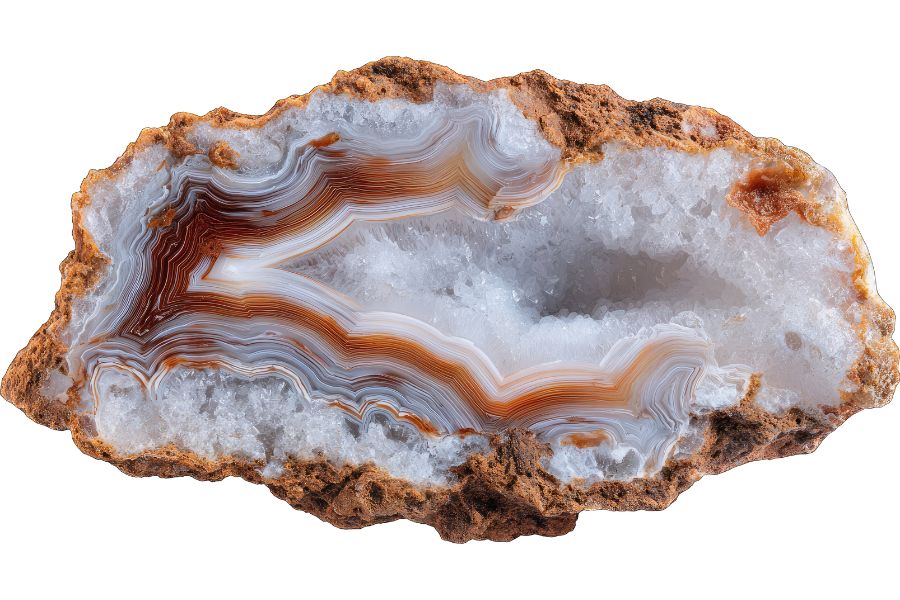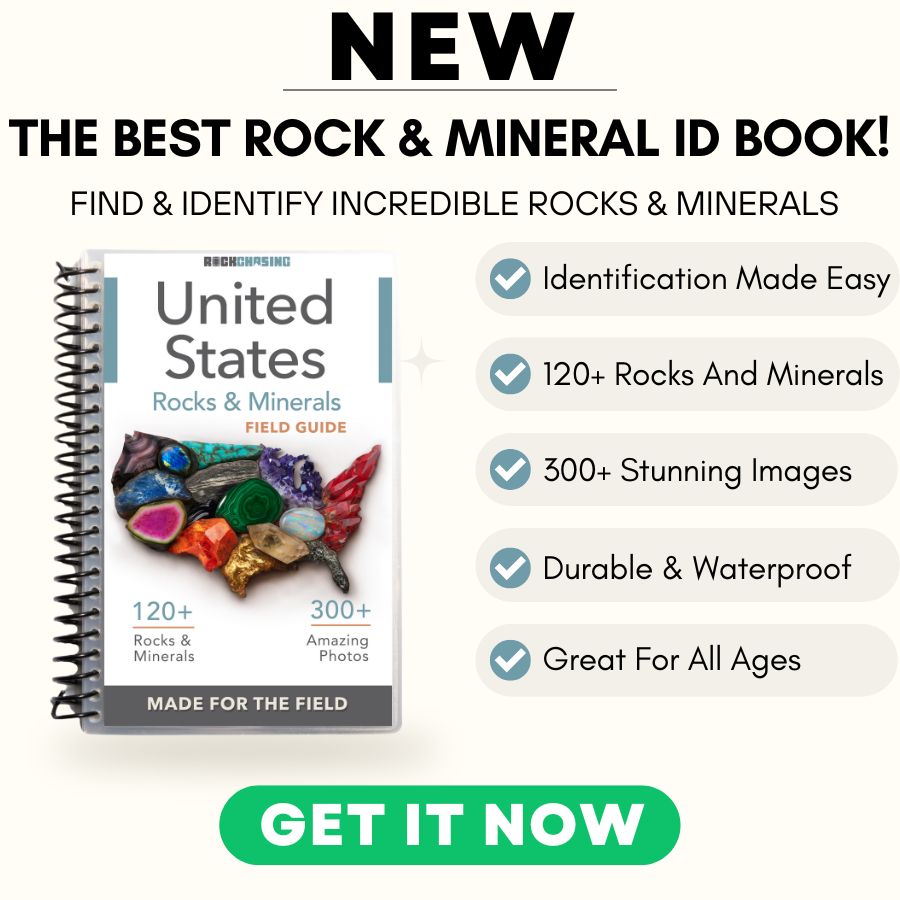Geodes in Indiana are one of the state’s best kept natural surprises and they’re hiding in places most people drive past every day.
Along creek banks farm fields and rocky road cuts in southern Indiana lie round ordinary looking rocks that crack open to reveal sparkling quartz crystals and sometimes stunning purple or smoky interiors.
What makes geode hunting here so exciting is that every find is a mystery until the moment it breaks open. Indiana’s limestone rich geology has created perfect conditions for geodes to form over millions of years and the hunt feels like a real life treasure search.
Whether you’re exploring riverbeds or gently washing gravel in shallow streams the chance of discovering a crystal filled geode with your own hands is what keeps people coming back again and again.
What Are Indiana Geodes?
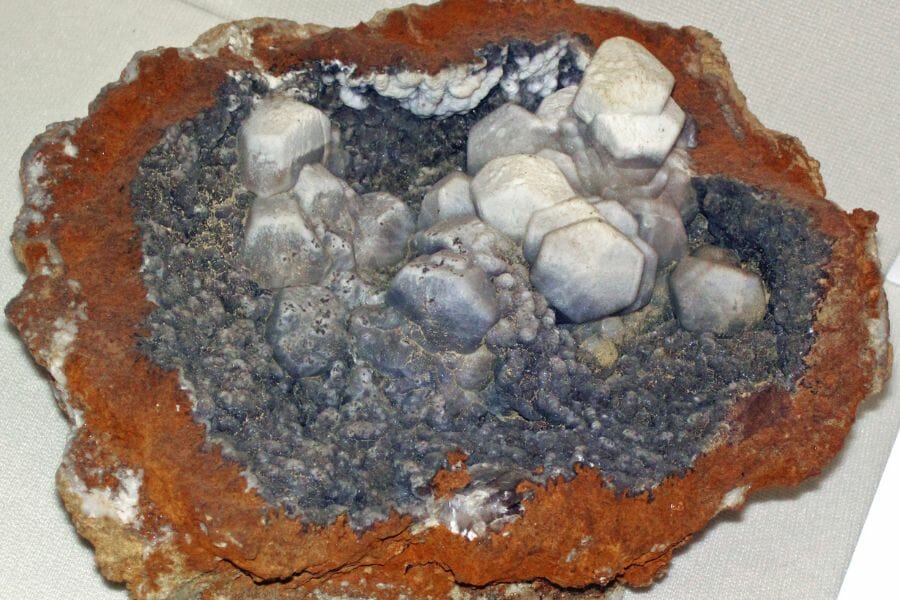
Geodes are natural formations, formed by volcanic activity or sedimentary processes, that are typically spherical or oblong in shape and have a hollow cavity lined with crystals.
They’re found all around the world and Indiana’s unique geology perfectly complements geodes’ formation process!
Inside the geode, crystals can grow in a variety of shapes and colors depending on the type of mineral present.
Geodes are not only popular among collectors for their beautiful crystal formations; they are also significant in the field of geology. Indeed, geodes are a fascinating example of the natural beauty and complexity of our planet.
What does the outside of a geode really look like? We’ve put together a guide on this, too.
The Different Types of Geodes
There are quite a few different types of geodes that you can find and all of there are beautiful and interesting in their own way. These are the most common types and what they look like:
Clear Quartz Geode
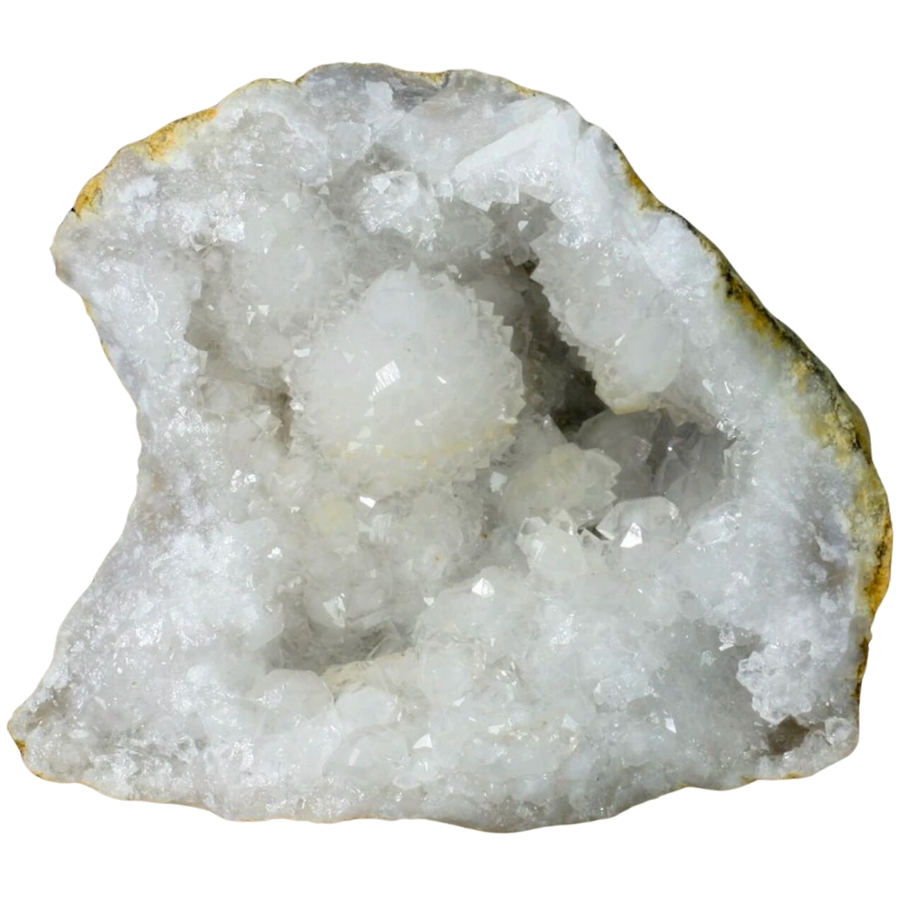
Clear quartz geodes are filled with shimmering, translucent crystals that catch the light in the most magical way. They are incredibly popular among rockhounds for their beauty and the pure, serene vibe they bring.
Clear quartz, also known as rock crystal, forms stunning, hexagonal crystals that can be either small and sparkly or large and commanding. Some are completely filled with crystals, while others have a hollow center, creating a sparkly little cave.
The value of quartz is influenced by how well-loved it is by many. They come in all sizes, too, from small enough to fit in your palm to as big as a person. The insides might be lined with fine, druzy crystals or feature larger, more defined points.
Where you can find clear quartz geode
You’ll often find clear quartz geodes in places with a history of volcanic activity. Brazil is famous for its spectacular specimens, but you can also find them in areas like Morocco, Mexico, and the USA.
If you need more information on where to find geodes, check out our article on that.
If you want REAL results finding incredible rocks and minerals you need one of these 👇👇👇
Finding the coolest rocks in isn’t luck, it's knowing what to look for. Thousands of your fellow rock hunters are already carrying Rock Chasing field guides. Maybe it's time you joined the community.
Lightweight, mud-proof, and packed with clear photos, it’s become the go-to tool for anyone interested discovering what’s hidden under our red dirt and what they've already found.
Join them, and make your next rockhounding trip actually pay off.
What makes it different:
- 📍 Find and identify 140 incredible crystals, rocks, gemstones, minerals, and geodes across the USA
- 🚙 Field-tested across America's rivers, ranchlands, mountains, and roadcuts
- 📘 Heavy duty laminated pages resist dust, sweat, and water
- 🧠 Zero fluff — just clear visuals and straight-to-the-point info
- ⭐ Rated 4.8★ by real collectors who actually use it in the field
Smoky Quartz Geode
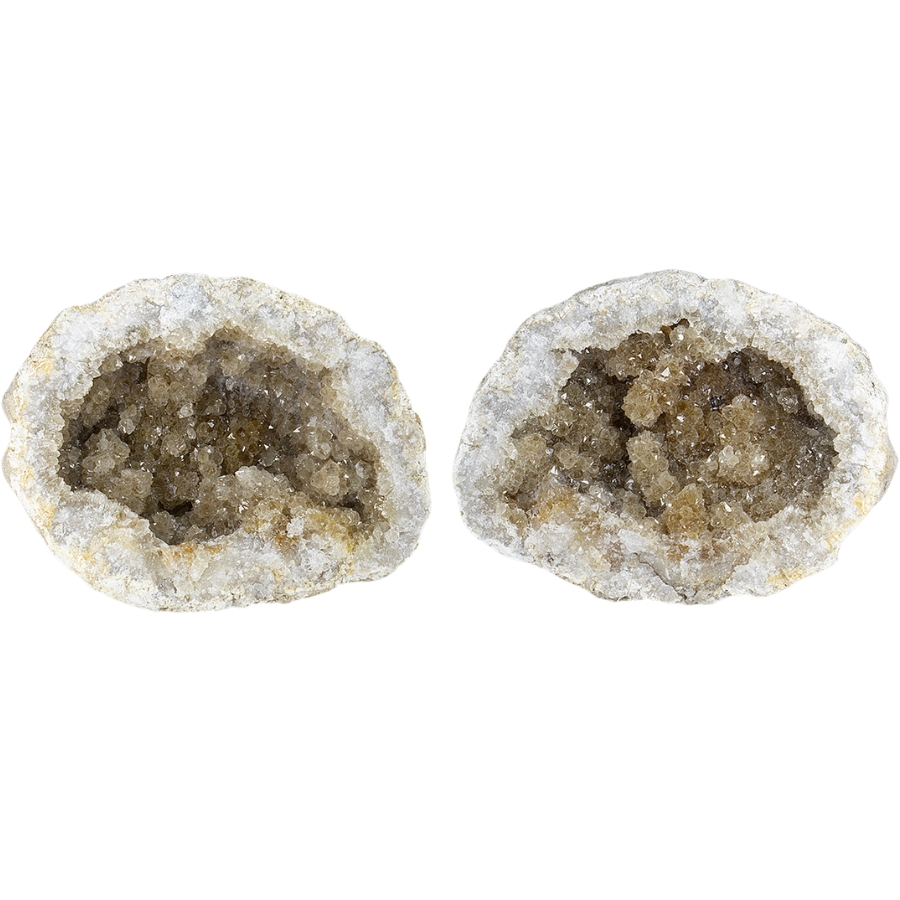
Smoky quartz geodes have a mysterious vibe, thanks to their dark, smoky crystals. It gets its intriguing color from natural radiation, which turns it from clear to a range of browns, from light and wispy to deep and intense.
What’s fascinating about smoky quartz geodes is the variety they offer. Some have a light, almost ethereal smokiness, while others are so dark they’re nearly black.
The crystals inside can vary too, from sharp, well-defined points to clusters of smaller, shimmering crystals. It’s this variety that keeps rockhounds coming back for more, as no two smoky quartz geodes are ever the same.
Where you can find smoky quartz geode
Smoky quartz geodes are found in places with the right conditions for quartz to capture the smoky color, like in several states in the USA. Brazil and Madagascar are also well-known for their stunning smoky quartz geodes.
Rose Quartz Geode
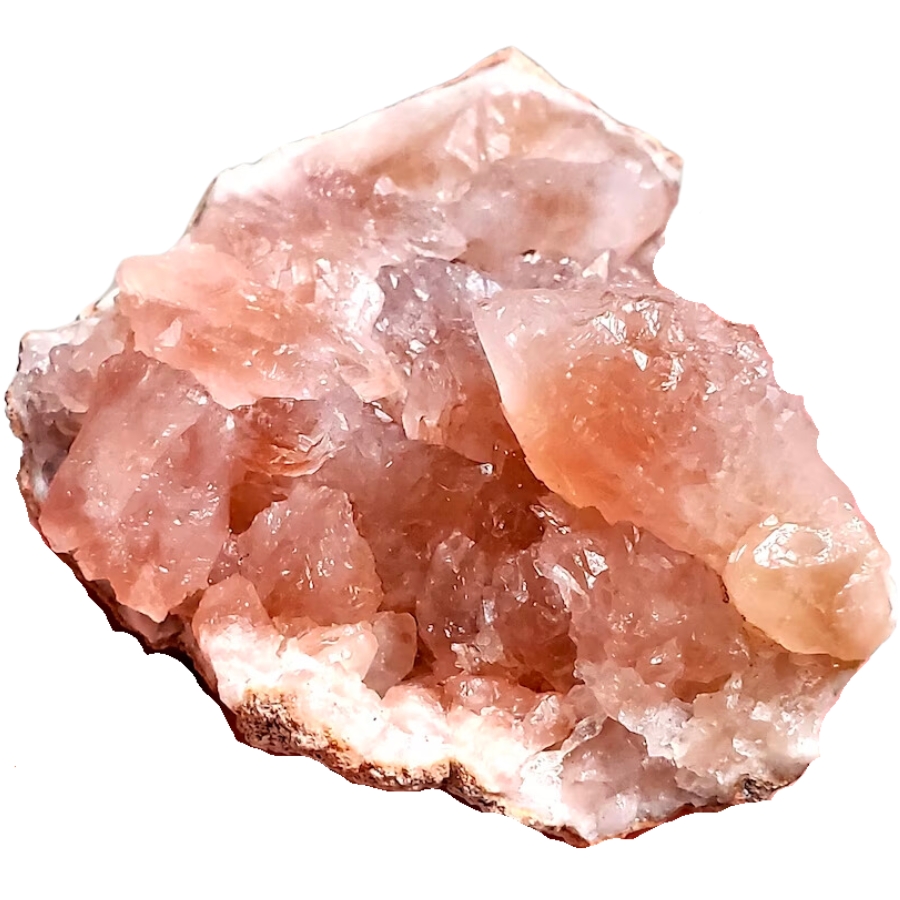
With their warm, gentle pink hues that seem to glow from within, rose quartz geodes are like a piece of the sunset in your hands. They’re filled with rose quartz, a crystal known for its soft, inviting color.
This type of quartz gets its lovely shade from trace amounts of titanium, iron, or manganese. They can range from a very pale, almost clear pink to a deeper, more vibrant shade.
In many cultures, rose quartz has been a symbol of love and healing. It’s often called the ‘love stone’ because people believe it promotes feelings of love, happiness, and emotional healing.
Amethyst Geode
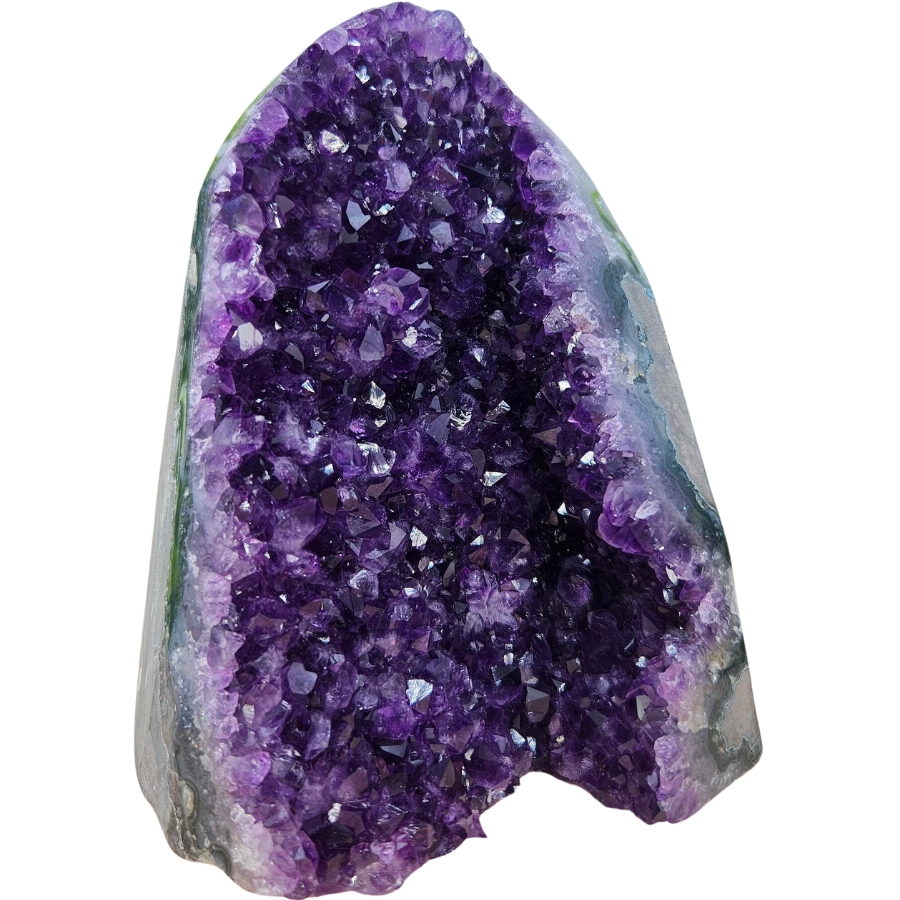
Amethyst geodes are filled with deep purple crystals that seem to sparkle and dance in the light. These geodes are super popular because of their stunning beauty and the rich color that ranges from light lavender to deep violet.
Its color comes from iron impurities and the natural radiation from the rocks around them. Each amethyst geode is distinct. Some are small enough to fit in your hand, while others can be as big as a person!
Inside, you might find tiny, delicate crystals or huge, jagged points. It’s this variety that makes each amethyst geode a special discovery.
For a long time, the price of amethyst goes more than just how it looks. Many believe it has calming and protective properties. It’s often called the ‘stone of peace’ and is used in jewelry, meditation, and decoration.
Where you can find amethyst geode
You’ll often find amethyst geodes in Brazil and Uruguay, which are famous for having some of the most beautiful specimens in the world. You can also find them in Mexico, Namibia, and even the USA.
Calcite Geode
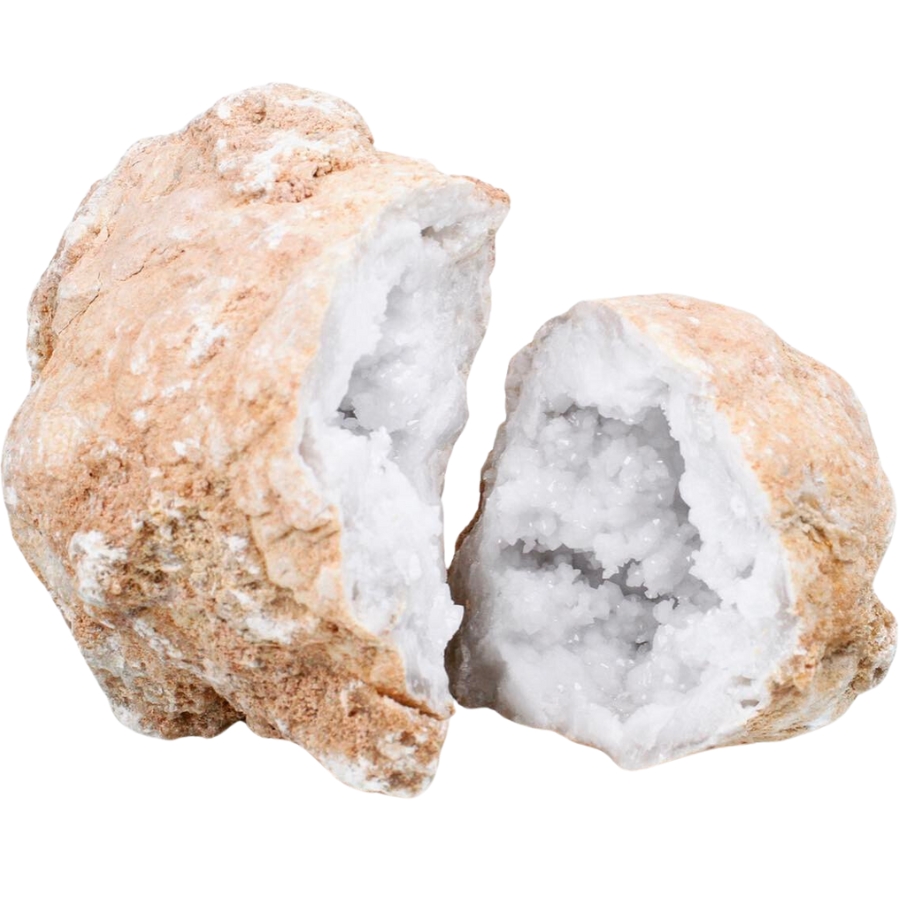
Calcite geodes are like hidden caves filled with sparkling treasures. They’re packed with calcite, a fascinating crystal that can be clear, white, or even full of vibrant colors like orange, pink, and green.
People have been fascinated by calcite for a long time because it has so many cool properties. For one, it can actually glow under ultraviolet light. It’s also used in a lot of everyday things like toothpaste and construction materials.
But beyond its practical uses, how much calcite is worth is due to simply how beautiful it is to look at and how it adds a delicate touch to any collection.
Where you can find calcite geode
You’ll often find calcite geodes in places where there’s been a lot of water activity, like old riverbeds and hot springs. Mexico is a hotspot for these colorful beauties, but you can also find them in Iceland, the USA, and Brazil.
Celestite Geode
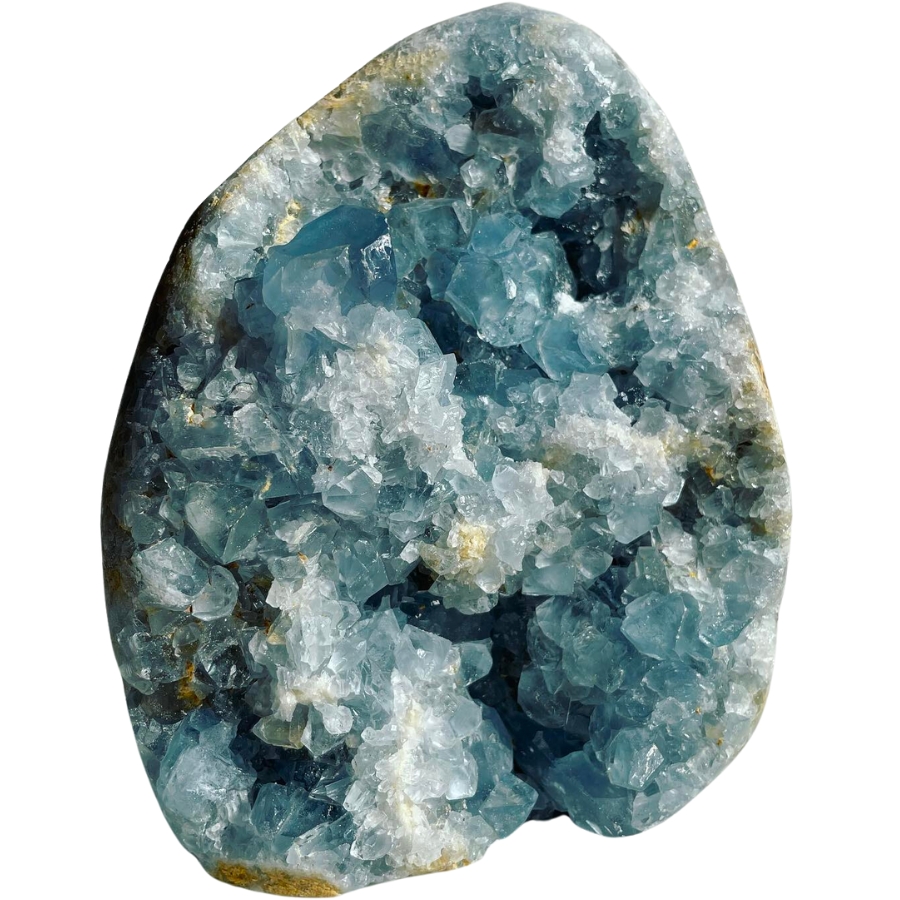
Celestite geode contains soft blue crystals that sparkle and shine. It got its name from the Latin word for ‘heavenly’, which makes perfect sense when you see its gentle, soothing color.
This geode seems to glow with an inner light. Its crystals can range from a very pale, almost clear blue to a deeper, more vibrant sky blue. It might be made up of tiny, delicate crystals or larger, more dramatic ones.
Besides their beauty, celestite crystals have a fascinating history. People have used them for centuries in jewelry and as decorative objects. Many also believe that it has calming and uplifting properties.
Where you can find celestite geode
Often, celestite geodes are found in places with ancient seabeds or salt deposits. Madagascar is known for its beautiful specimens, but you can also find them in Poland, Libya, and the USA, particularly in areas like Ohio and Michigan.
Agate Geode
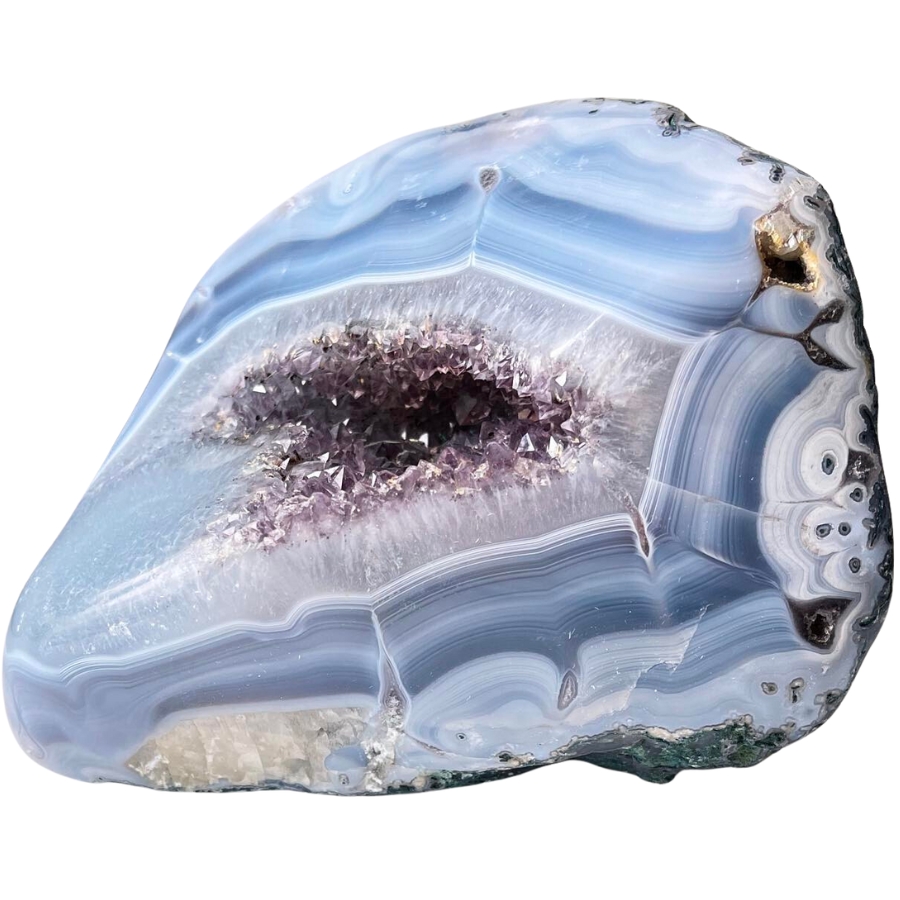
When you crack an agate geode open, it’s like entering a whole new world! It contains agate, a type of quartz that can show off a whole rainbow of colors.
The variety that it offers affects the price of agate geode. From the outside, they might look pretty ordinary, but inside, you’ll find incredible bands of colors like red, yellow, green, and blue.
Some even have patterns that look like waves or even landscapes. And did you know that some agate can even glow under UV light? Certain types can light up a bright green, making them even more awesome.
Where you can find agate geode
Agate geodes are found all over, but some of the most amazing ones come from Brazil and Uruguay.
You can also find them in the USA, Mexico, and Madagascar. These spots are great for agate geodes because they have just the right conditions for the agate to form its stunning layers.
Citrine Geode

Citrine geodes are like little suns, glowing with warm, golden light. These geodes are filled with citrine, a type of quartz that ranges from a pale, lemony yellow to a deep, honey amber.
Most citrine starts as amethyst, another type of quartz, but when it’s heated, whether by nature’s underground heat or by people, it changes to the golden color we know and love.
Many people believe citrine brings joy, energy, and even wealth. It’s often called the ‘merchant’s stone’ because shopkeepers would keep it in their cash registers for good luck. There’s really no doubt if citrine is valuable or not.
Where you can find citrine geode
Many places bear natural citrine geodes, but some of the most beautiful ones come from Brazil. They’re also found in Madagascar, Russia, and even in the USA.
Pyrite Geode
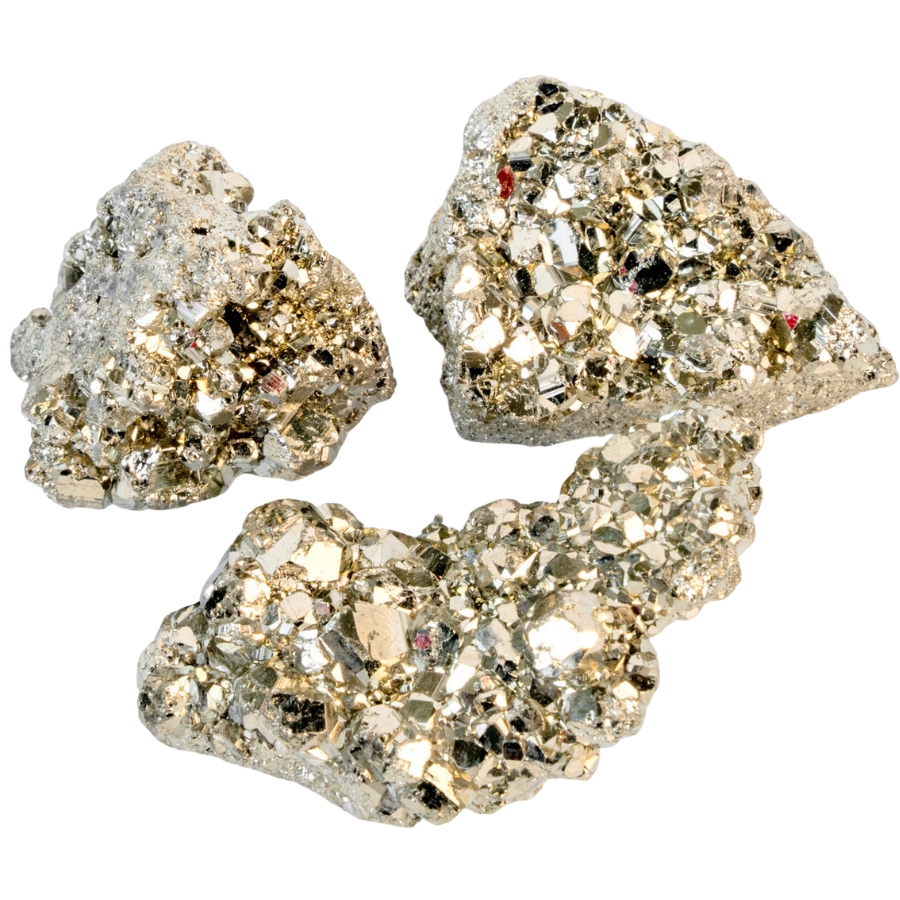
Pyrite geodes are like hidden vaults filled with golden treasures. They’re packed with pyrite, a mineral that’s also known as ‘fool’s gold’ because of its shiny, metallic appearance that looks a lot like real gold.
The pyrites in this type of geode can form in perfect cubes, clusters, or even round balls called ‘pyrite suns’. And when they catch the light, they glitter like real gold, which reflects the value of pyrite geodes.
Pyrite has a pretty interesting history. People have been mistaking it for gold for thousands of years, which is how it got its nickname. It’s been used in jewelry, and some people even believe it can attract wealth and good luck.
Where you can find pyrite geode
While you can find pyrite geodes in lots of places, they’re especially common in countries like Peru, Spain, and Italy. You can also find them in the USA, particularly in Illinois and Missouri.
Chalcedony Geode
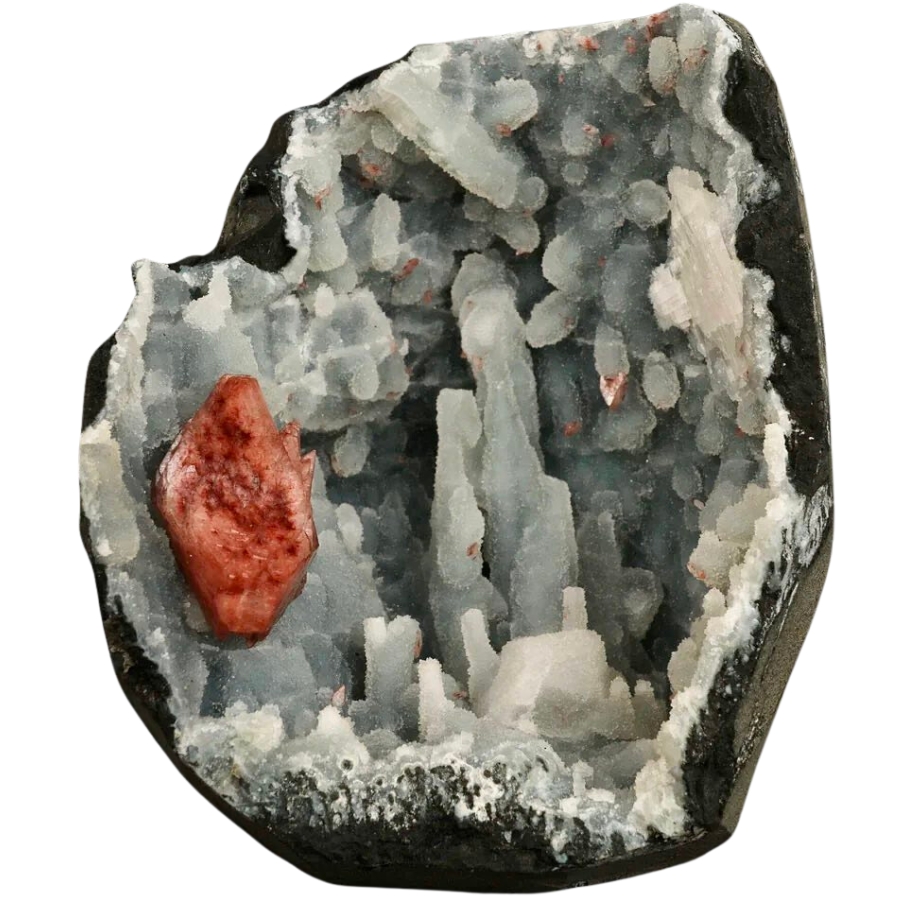
Chalcedony geode is packed with chalcedony, a form of quartz that’s known for its waxy luster. It can range from almost transparent to a milky opacity. Its soothing appearance makes it sought after by collectors.
Its colors can be pale and subtle, like blue, pink, or gray, or it might be a bit deeper and more striking. The way it forms can create patterns that look like landscapes or even waves. Sounds interesting, right?
Chalcedony has been used in all sorts of art and jewelry. Some even believe in the value of chalcedony geode to calm and soothe the mind.
Where you can find chalcedony geode
If you want to find chalcedony geodes, you should know that many places have them, but they’re particularly common in Brazil, India, and Madagascar.
You can also find them in the USA, especially in states like California, Arizona, and Oregon, so those are more options for your search.
Jasper Geode
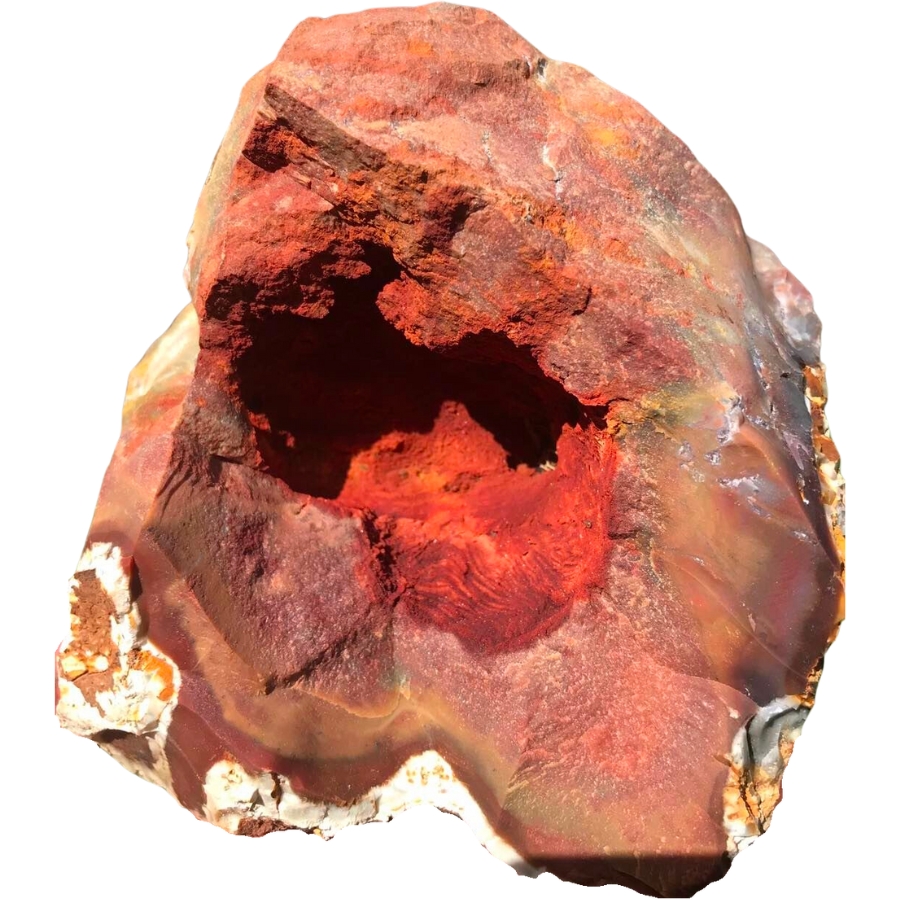
Jasper geodes contain jasper, which comes in almost every color you can think of. Finding one is like finding a natural piece of art, with swirls, spots, and stripes that make every piece unique.
Their huge variety of colors and patterns can mark up the price of jasper geodes. Some are bright red, others are deep green, and some even have multiple colors mixed together.
And the patterns can be just as varied, with stripes, spots, or even pictures that look like landscapes. It’s this variety that gave jasper a long history of being loved by people all over the world.
It’s been used for decoration, in jewelry, and even as a symbol of protection. Many believe that it has special powers, like bringing courage or calming the mind.
Where you can find jasper geode
You’ll find jasper geodes in lots of places. However, some of the most amazing ones come from Brazil, India, and the USA, which all have the perfect mix of minerals and conditions for jasper to form its beautiful patterns inside geodes.
Carnelian Geode
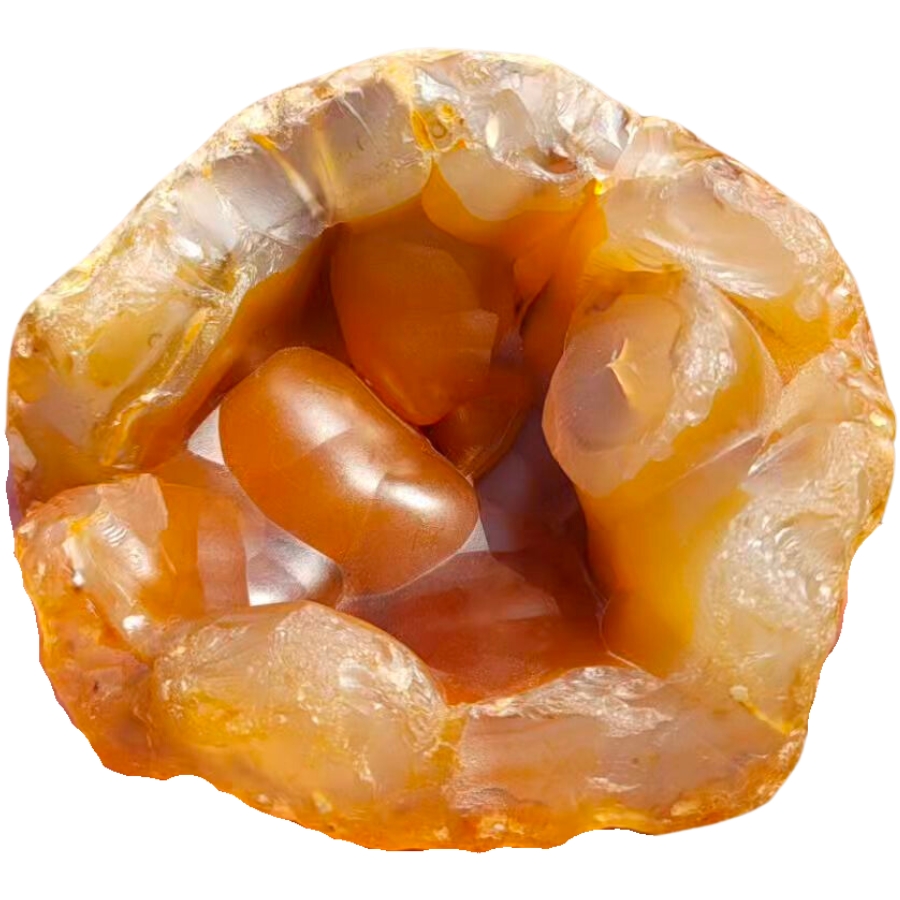
Carnelian geodes are like fiery sunsets captured in stone, with their warm, glowing reds and oranges that light up any room. Filled with carnelian, a type of quartz that’s known for its vibrant color, a carnelian geode is like a natural furnace.
Some are a soft, peachy orange, while others are a deep, fiery red. And just like other geodes, the inside might have tiny, sparkling crystals or larger, more dramatic ones. The beauty of these crystals contributes to the value of carnelian geodes.
Carnelian has a pretty cool history too. It’s been used for thousands of years in jewelry, carvings, and as a symbol of power and status. Many believe that it can boost courage, bring good luck, and even help people speak with confidence.
Selenite Geode
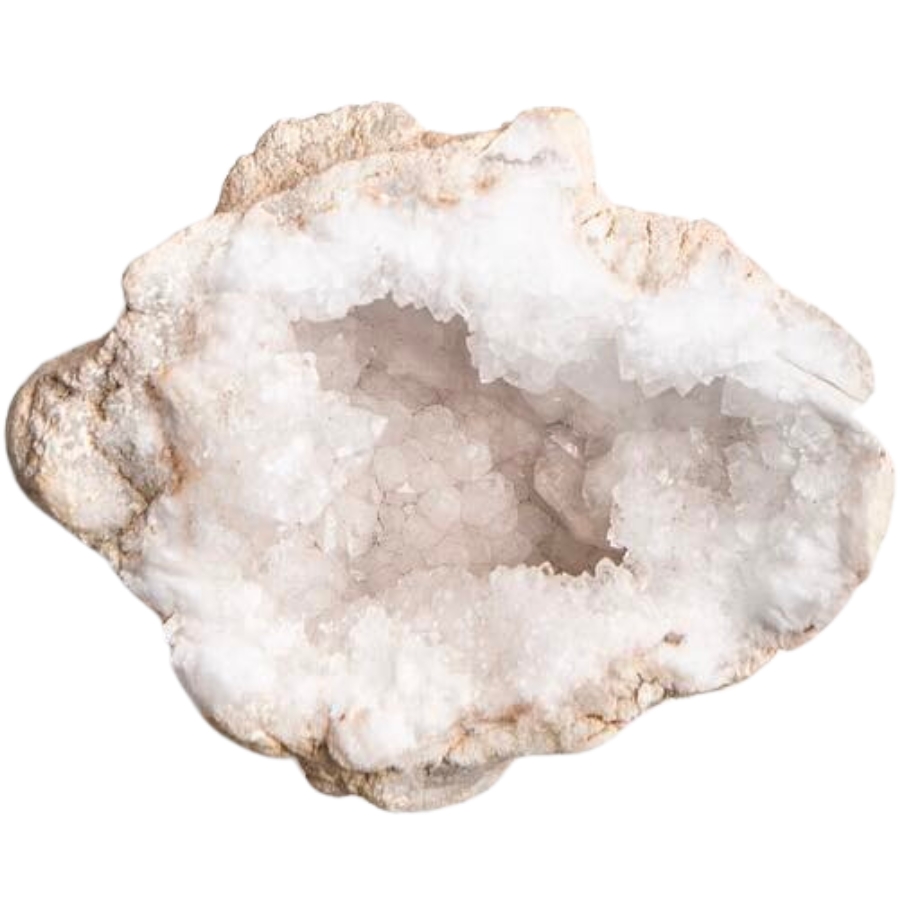
Selenite geodes are like moonbeams caught in stone, with their soft, milky glow and delicate crystals. Selenite is a type of gypsum that’s known for its clear, shimmery appearance.
When you see one, you’ll be amazed at how they seem to light up from within. The crystals can be long and thin, like swords of light, or they might form in delicate, flower-like clusters.
The value of selenite goes beyond its beauty. It’s been used for centuries in decorations and as a calming stone. Many believe that selenite has special powers like bringing peace, clarity, and protection.
Where you can find selenite geode
You can find selenite geodes in places where there are lots of evaporating water, like salt lakes and hot springs. One of the most famous spots for finding them is in Mexico, especially around the Cave of the Crystals.
You can also find them in Morocco, where they’re pulled from ancient dry lake beds. In the USA, places like Oklahoma are known for their beautiful selenite geodes.
Rhodochrosite Geode
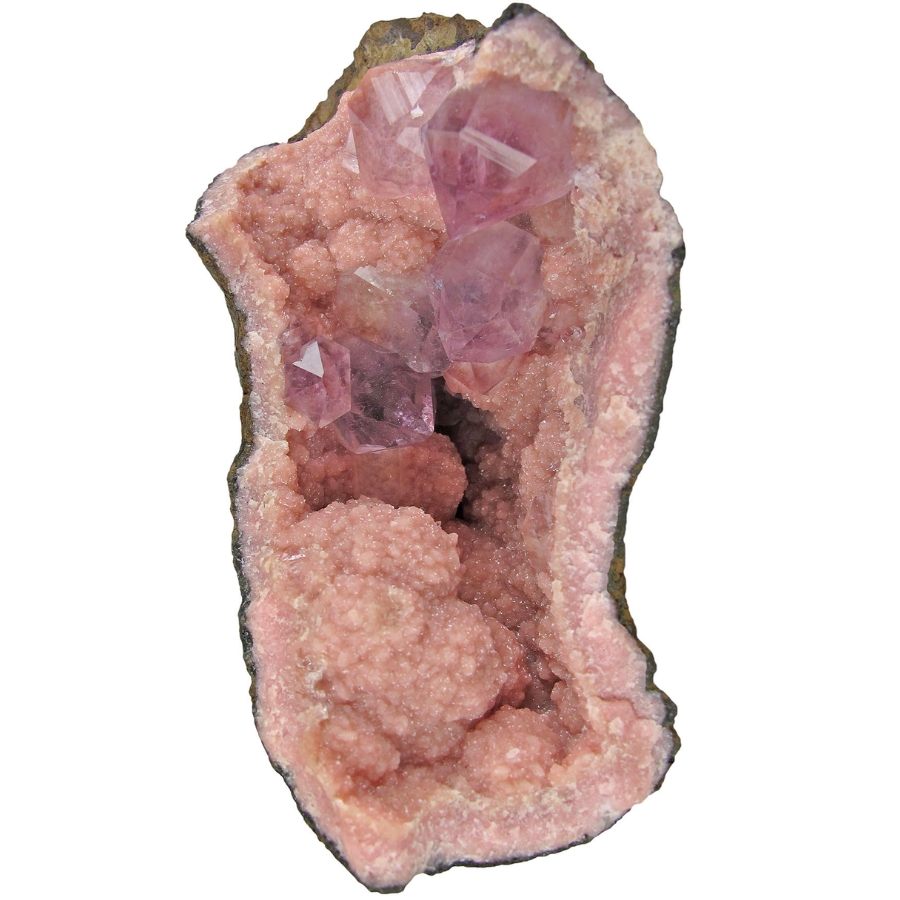
Filled with rhodochrosite, a mineral known for its rich, rosy hue, rhodochrosite geodes are like hidden bouquets of pink and red roses. Finding one is like uncovering a secret garden showing off shades of pink, red, and even creamy white.
The way the colors swirl and layer in rhodochrosite geodes makes it all the more interesting. Some have bands of different shades, while others might have patterns that look like flower petals.
Many also believe this geode has the power to help with emotional healing and love. It’s often called the ‘stone of the compassionate heart’ because of these beliefs.
Fluorite Geode
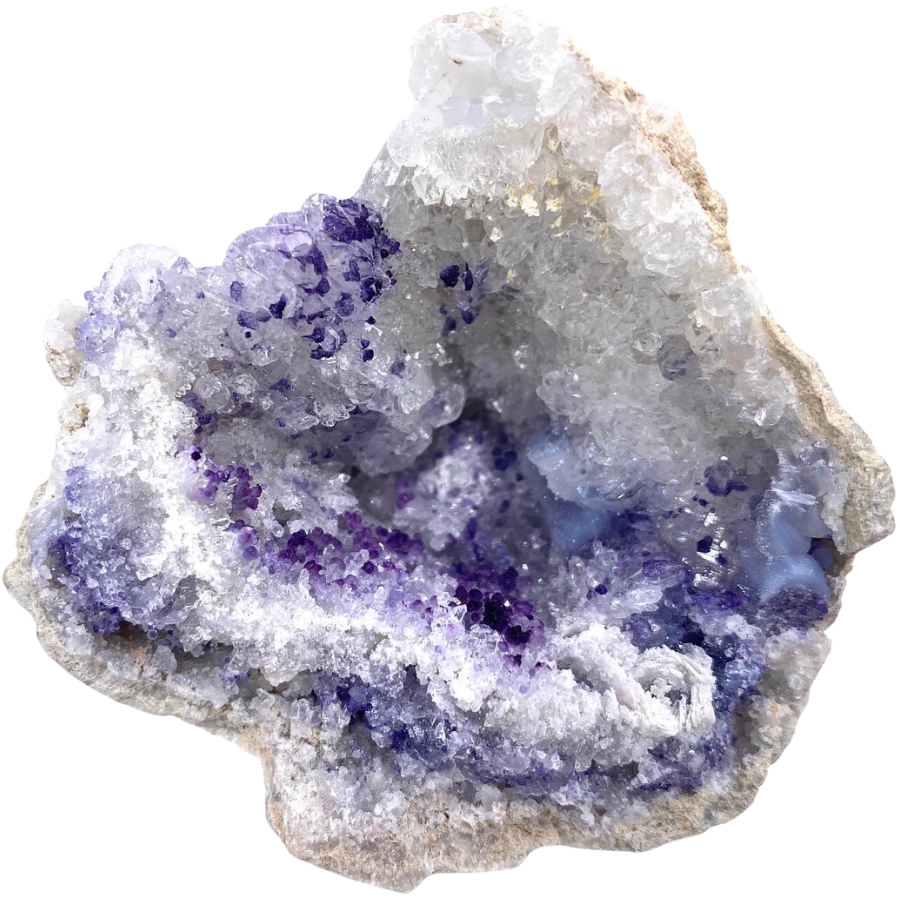
Fluorite geodes are like looking into a kaleidoscope, with all their cool colors and patterns. Fluorite is a mineral that can be just about any color of the rainbow.
Did you know that the colors of the fluorite inside this geode can change under different lights? Some fluorite can glow a bright blue or green when you shine a UV light on it.
And not only are they pretty to look at, but they also have some pretty neat uses. Fluorite is used in making things like lenses for cameras and telescopes because it’s so clear.
The price of fluorite geode can vary a lot, depending on many factors. But generally speaking, the more clear and colorful it is, the more it might cost.
Where you can find fluorite geode
One of the best spots to find fluorite geodes is in China. You can also find them in places like Mexico, where the fluorite comes in bright, beautiful colors. In the USA, states like Illinois and Kentucky are known for having fluorite too.
Stilbite Geode

Stilbite geodes have soft, peachy pink, and sometimes clear or white crystals of stilbite, a part of the zeolite family.
The crystals inside this geode often grow in thin, flat plates or larger, more complex clusters that look like a bunch of flower petals. And because of their soft colors, they’ve got a gentle, soothing look.
Stilbite is also known for its ability to help with things like creativity and intuition. Some even believe it can help with sleep and calming the mind.
Another interesting thing about stilbite is that it’s often found with other minerals. So sometimes, when you find a stilbite geode, you might also see other cool minerals like apophyllite or calcite growing with it.
Where you can find stilbite geode
Stilbite geodes are found in some really interesting places. In India, you can find some of the most beautiful ones. You can also find them in Iceland and the USA, specifically in New Jersey and Oregon.
Scolecite Geode
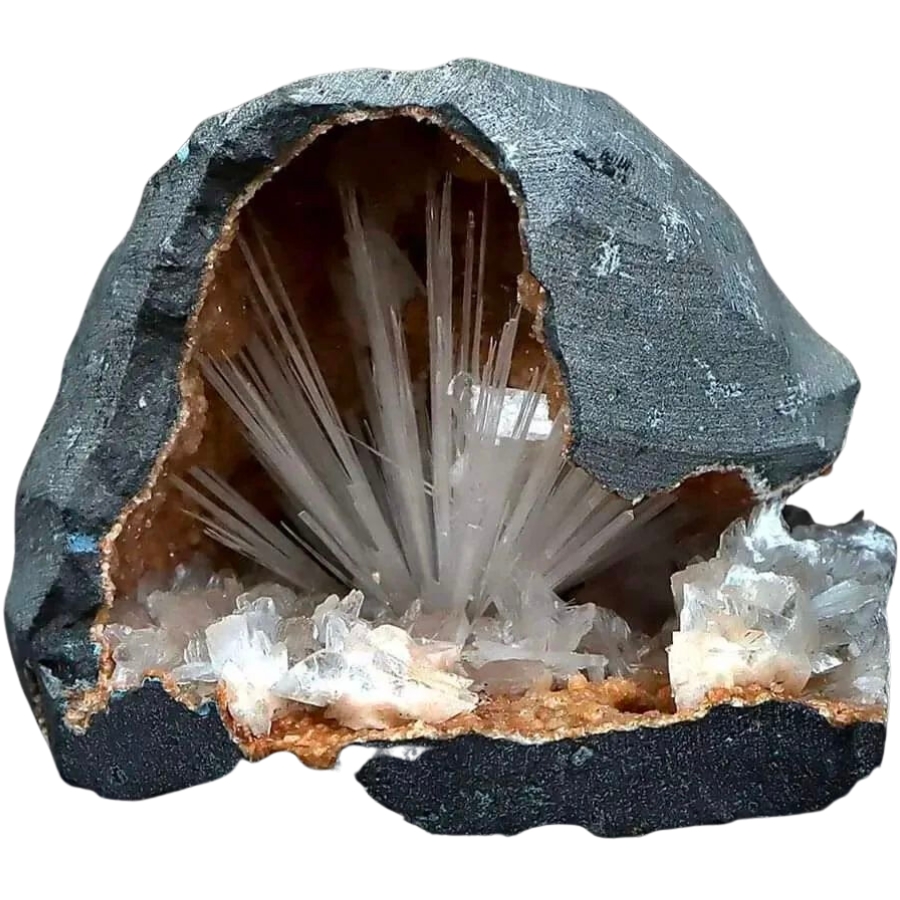
Scolecite geodes are like frozen fireworks, with their delicate, needle-like crystals that burst out in all directions. They contain scolecite, a mineral that’s known for its thin, long crystals and often pearly white color.
Scolecite crystals often form inside geodes in clusters that look like a bunch of white, spiky stars all gathered together. And because the crystals are so thin and fine, they sometimes seem to glow when the light hits them just right.
Despite its fragile appearance, scolecite crystals are pretty tough. They’re part of the zeolite family, minerals that are known for being strong and durable. So, even though it looks like it could break at any moment, it’s much stronger than it seems.
Where you can find scolecite geode
You can find amazing specimens of sparkly scolecite geodes in India and Iceland. In the USA, places like New Jersey are known for having this neat find, too.
Apophyllite Geode
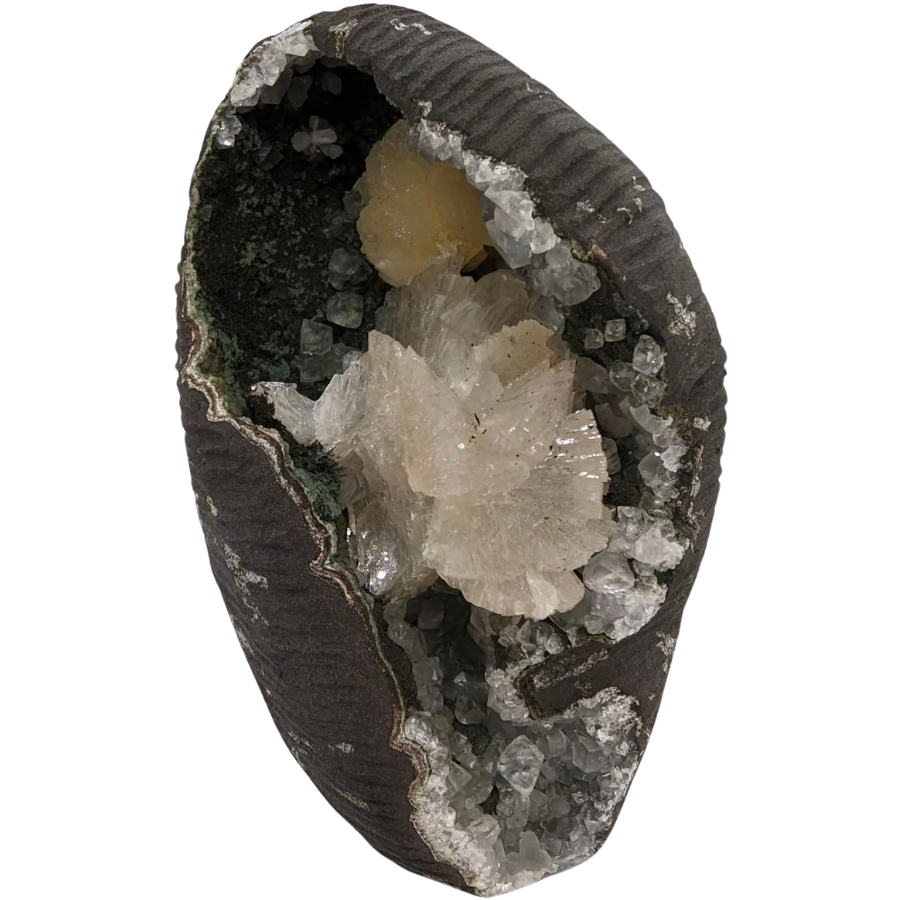
Apophyllite geodes are like mini crystal palaces, with their clear, sparkling crystals that catch the light in amazing ways. Apophyllite is known for its bright, shiny surfaces and often pyramid-like shapes.
Some crystals in apophyllite geodes are so clear they look like glass, while others might have a gentle green or pink hue. And because they often form in pointed shapes, they catch the light and sparkle from every angle.
Interestingly, apophyllite is one of the few minerals that can ‘flake’ when heated. This means that when it gets warm, thin layers can peel off like pages in a book. It’s a unique feature that makes it even more interesting.
Where you can find apophyllite geode
Apophyllite geodes are usually found in places where there’s been some volcanic activity. You can find them in India, Brazil, and the USA.
These spots are great because they have old lava flows and volcanic rocks, which are perfect for apophyllite to form its clear, sparkling crystals.
Aragonite Geode
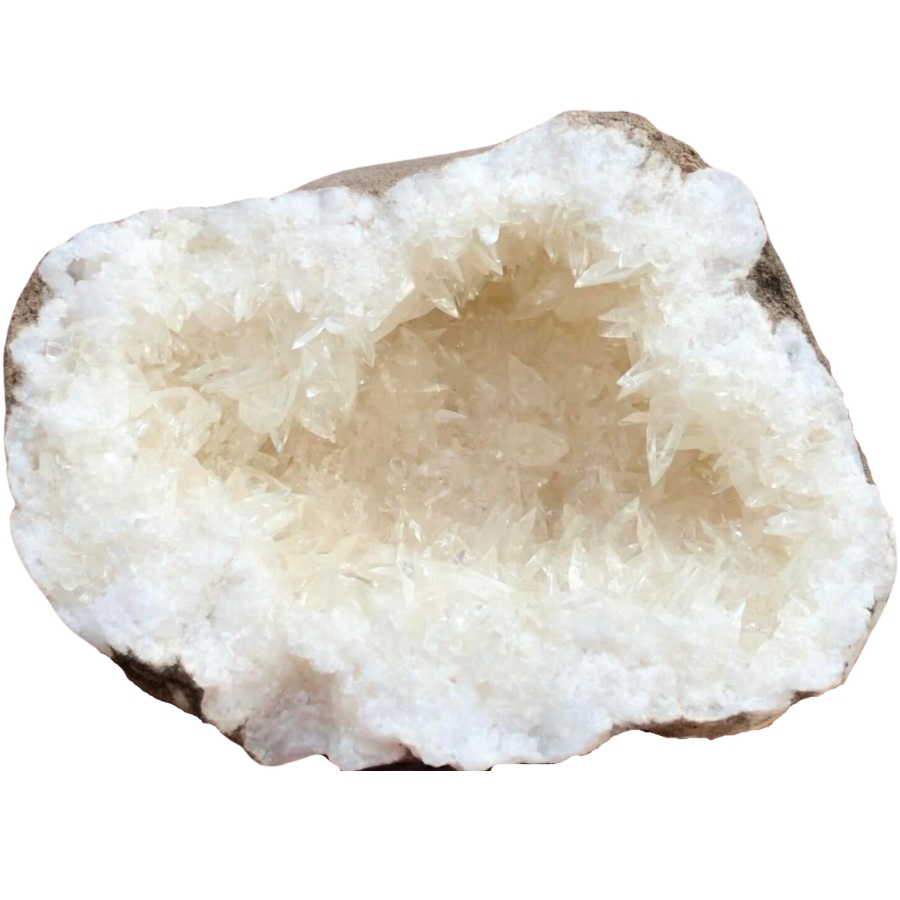
Aragonite geodes are like tiny, natural sculptures, each one full of spikes and twists that catch your eye. They’re made of aragonite, a mineral that forms in star-like clusters called ‘starbursts’.
Aragonite forms in a cool way. It often starts in places where there’s lots of water. As the water moves and evaporates, it leaves behind the minerals that build up into the spiky crystals we see in the geodes.
What makes aragonite geodes so distinct is their shape. The crystals don’t just grow in smooth, flat faces; they burst out in all directions, creating a wild and spiky look. This unique appearance is one reason why they’re so valued.
Septarian Geode
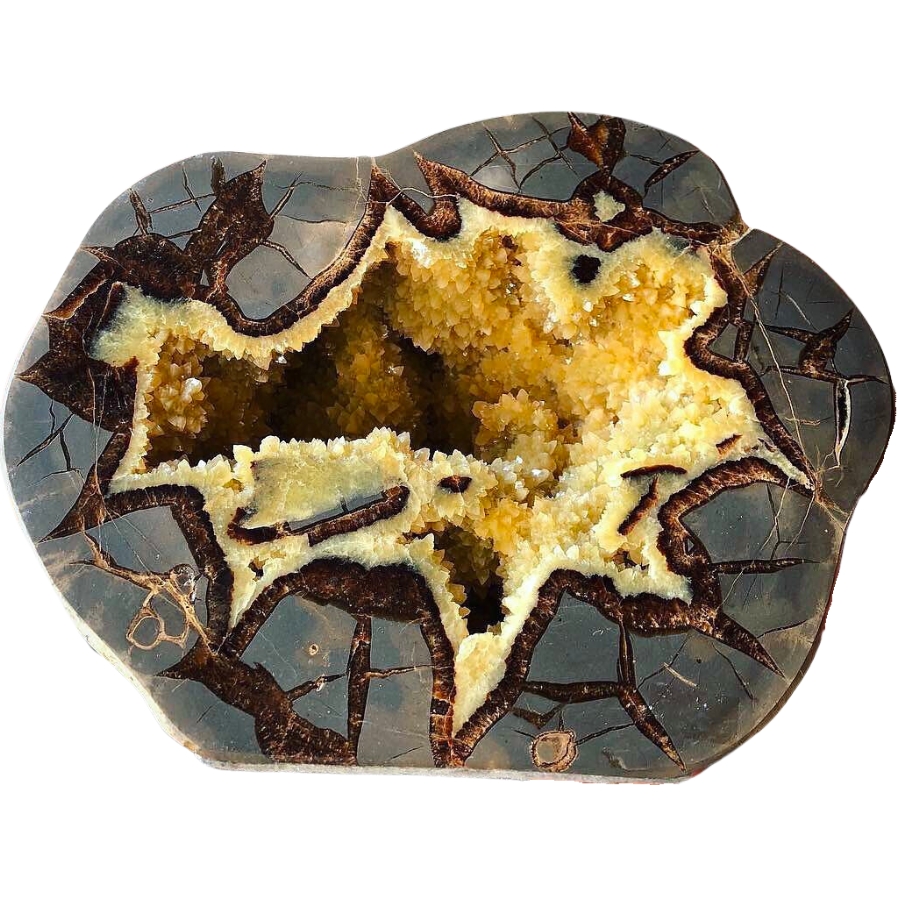
Septarian geodes are like natural puzzles, each one a mix of different minerals that come together in a unique way. They usually have a combination of yellow calcite, brown aragonite, and grey limestone.
Septarian geodes start as mud balls that crack as they dry out. Then, different minerals seep into the cracks and fill the spaces. This process creates the distinct look of septarian geodes, with their crackled patterns and mix of colors.
In fact, the name “septarian” comes from the Latin word “septum,” which means “partition” because of the way the minerals are separated into distinct sections.
The different minerals and the patterns in a septarian geode are like a record of what happened over thousands of years. This unique appearance is one reason why they’re so valued.
Malachite Geode
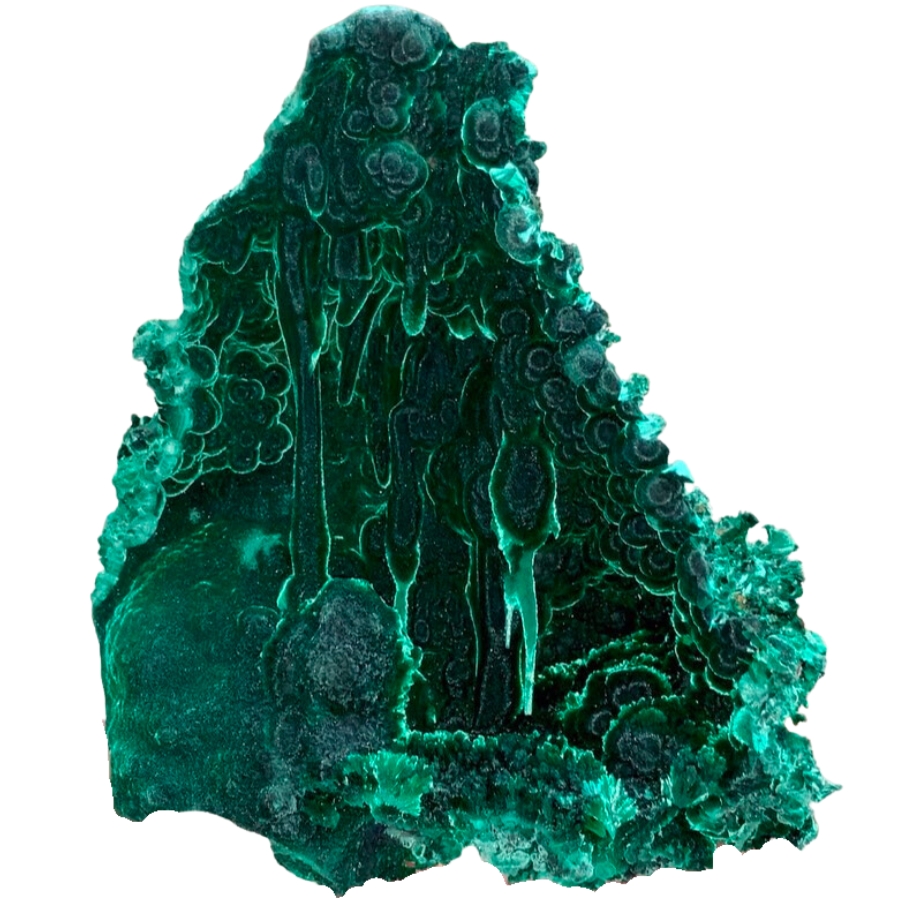
Malachite geodes have deep, vibrant green colors swirling in patterns that look like the rings of ancient trees. When you open one, it’s like peeking into a miniature forest, full of shades and stripes of green.
Malachite forms from copper deposits. As water moves through the copper, it picks up bits of the metal and other minerals. When the water evaporates, it leaves behind the beautiful green malachite.
The value of malachite comes from its striking beauty and its history. People have been drawn to its deep green color for thousands of years, using it in jewelry, decorations, and even as a pigment for paint.
In the past, some believed it could protect children from evil spirits and even help businessmen make good deals. It’s been a symbol of protection and power for a long time.
Azurite Geode
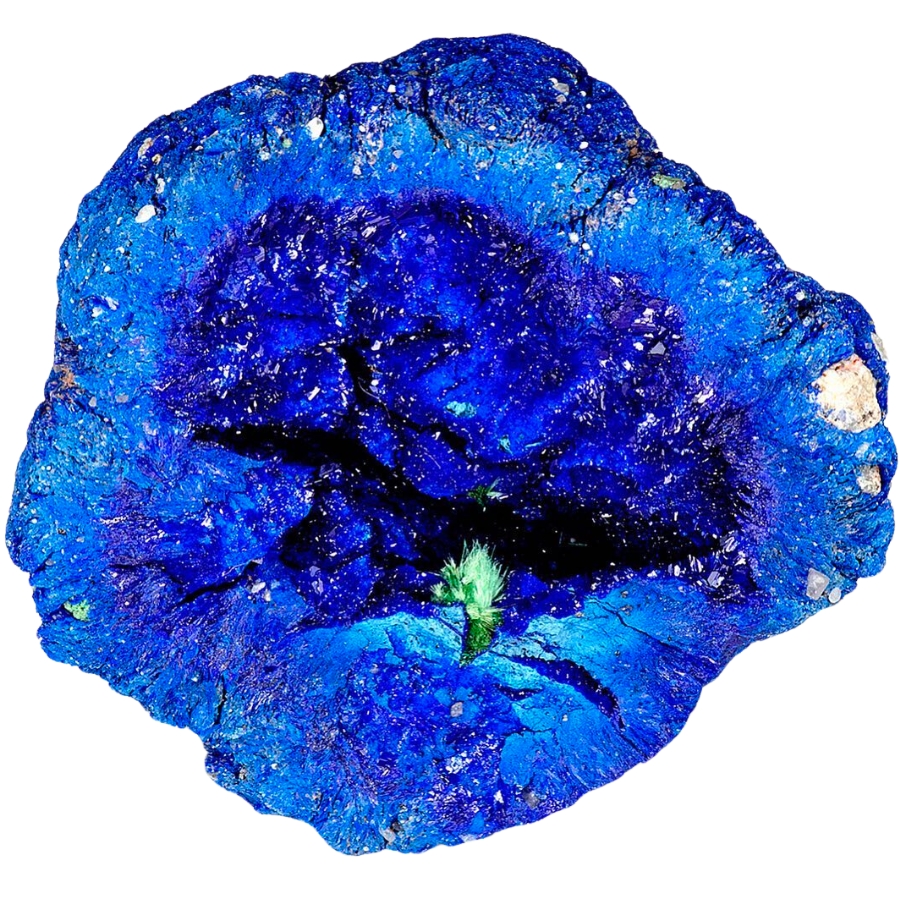
Azurite geodes are filled with stunning, deep blue-colored crystals. Opening one is like uncovering a drop of the ocean with different shades of blue that seem to dance and swirl inside.
Azurite starts to form with copper ore. As water moves through the copper, it picks up bits of the metal and other minerals. Over time, this mixture changes and turns into the beautiful blue azurite.
The deep blue color of azurite has been loved for centuries, used in jewelry, and even ground up as a pigment for paint. Its vivid blue color is so famous, it was used to create the bright blues in many Renaissance paintings.
Despite its hardness, it’s actually quite fragile and can slowly change into another mineral called malachite over time. This transformation is a cool example of how minerals can change right before our eyes.
Where you can find azurite geode
Azurite geodes are usually found in places with lots of copper. You can find these deep blue rocks in the USA, especially in Arizona and Utah. You can also find them in Mexico and France, where the conditions are just right for them to grow.
Prehnite Geode

Prehnite geodes are like little globes of soft green light. Sometimes, its crystals inside can also be clear or yellow.
Prehnite usually grows in the spaces between rocks, where it’s cool and there’s a lot of water. Over time, as the water moves through these spaces, it leaves behind minerals that slowly build up into beautiful prehnite crystals.
It’s been used in jewelry and as a gemstone for centuries because of its beauty. The calm, gentle color of prehnite is so beloved, that it’s often called the ‘stone of unconditional love.’
Prehnite was actually one of the first minerals to be named after a person. Its discoverer, a Dutch colonel named Hendrik von Prehn, is who it’s named after.
Opal Geode
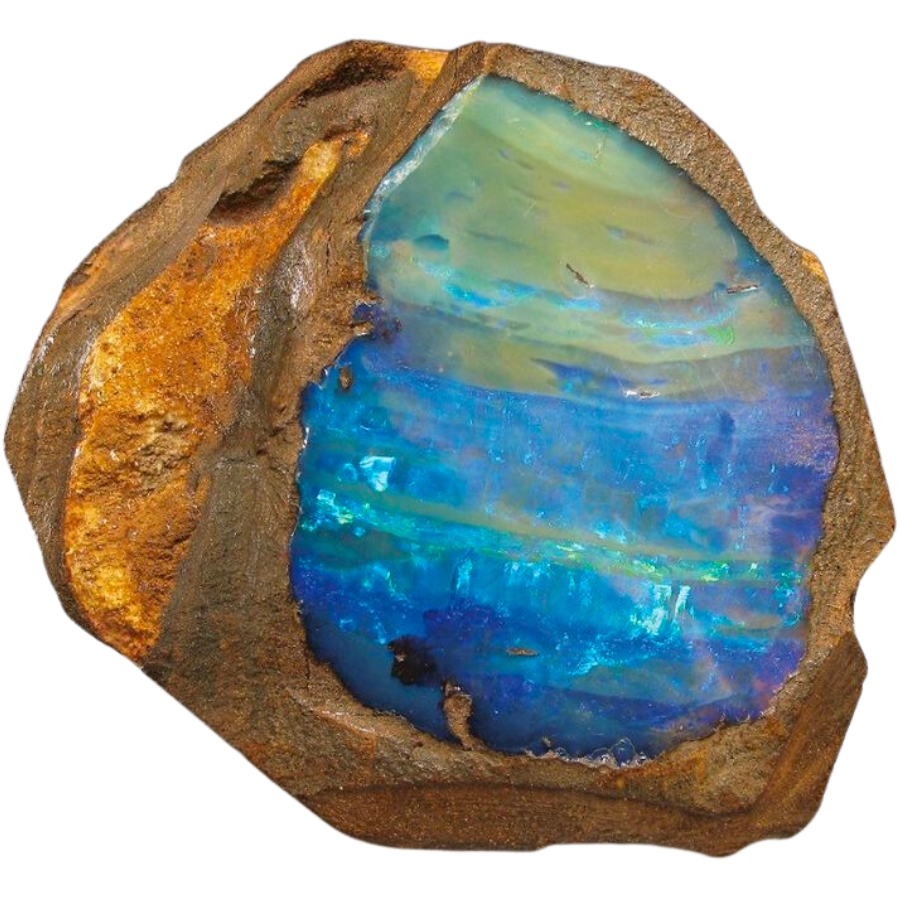
Opal geodes are filled with opals dazzling with their play of colors that can include blues, greens, pinks, and more.
Opal forms when water seeps into the ground, carrying silica with it. This silica-rich water fills up cracks and voids in rocks. As it evaporates, it leaves behind the silica, which slowly turns into the beautiful opal we see.
The value of opal geode comes from its stunning beauty and rarity. People have been drawn to its mesmerizing colors for centuries, using it in jewelry. The play of color in opal is so unique that it has its own name: opalescence.
And did you know that opal is Australia’s national gemstone? They even produce most of the world’s opal.
Where you can find opal geode
Opal geodes are usually found in places that have had a lot of volcanic activity. As we mentioned, Australia is known for its amazing opals. You can also find them in Brazil, Mexico, and the USA, especially in states like Nevada.
Epidote Geode

Epidote geodes contain usually dark, olive green colored crystals. Uncovering one is like discovering a secret patch of moss or leaves, with each one showing off shades of green that seem to whisper of ancient woods.
Epidote often grows where there are changes in temperature and pressure. As rocks change and shift, the right conditions are made for them to form.
Its name comes from the Greek word ‘epidosis,’ which means ‘increase.’ It’s because the mineral’s crystal faces often have one side longer than the other, making it look like it’s growing or increasing.
What makes epidote geodes so distinct is their color and the way the crystals group together. They often grow in long, thin shapes that cluster like a bunch of needles or blades. This unique appearance is one reason why they’re so valued.
Where you can find epidote geode
Epidote geodes are usually found in places that have a lot of activity under the ground, like where tectonic plates meet. This means they’re often discovered in mountain ranges and areas with lots of old, changing rocks.
Countries like Norway, Austria, and the USA, especially in Alaska, are known for their beautiful epidote specimens.
Hematite Geode

Hematite geodes are like holding a piece of the night sky in your hands, with their shiny, metallic surface that reflects light like stars.
The crystal hematite starts with iron-rich water seeping into the ground. As it moves and reacts with oxygen, it leaves behind the iron, which slowly turns into hematite.
The value of hematite geode comes from its crystals’ striking appearance and history. Its shiny surface has drawn people for centuries, so it’s used in jewelry, as a pigment for paint, and even for protection in battle.
The dark, metallic color of hematite is so unique, it’s been a symbol of strength and courage for a long time. Not only that— it’s the main ore of iron, which means it’s where most of the iron we use comes from.
- The deep experience and understanding of our team about the area
- Recommendations from local groups and clubs
- How easy it is to get the a particular location
- Safety and potential hazards when collecting
- Weighing private and public locations
- The ability for both experienced and novice geode enthusiasts to find great samples
With these factors in mind we’ve been able to put together a fantastic list that just about anyone can use!
The Best Places To Find Geodes in Indiana
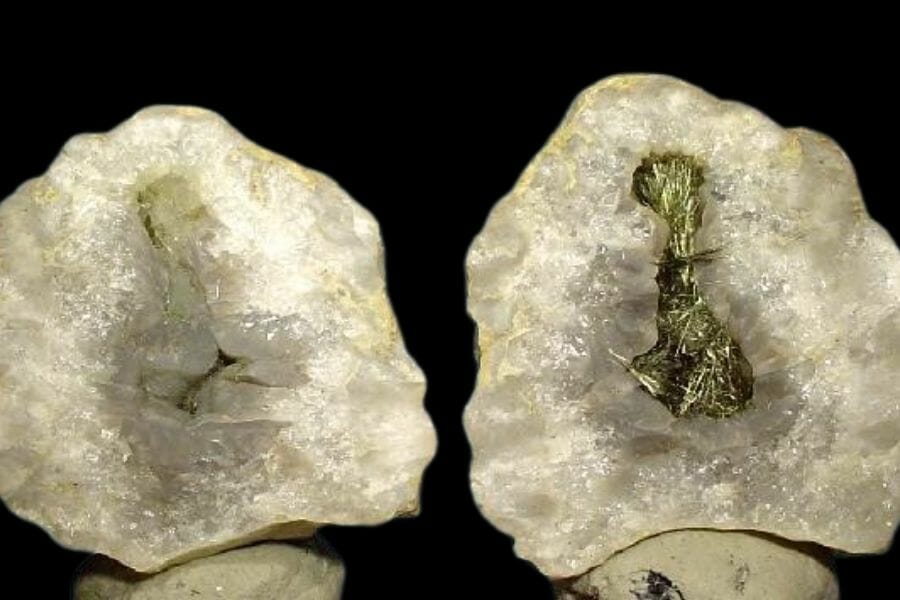
There are tons of great places to mine gems in Indiana, but they do not necessarily have geodes in them, too. The places we’ll share with you below are seldom known by gem hunters, but they are excellent locations if you want to find geodes in Indiana.
Always Confirm Access and Collection Rules!
Before heading out to any of the locations on our list you need to confirm access requirements and collection rules for both public and private locations directly with the location. We haven’t personally verified every location and the access requirements and collection rules often change without notice.
Many of the locations we mention will not allow collecting but are still great places for those who love to find beautiful rocks and minerals in the wild without keeping them. We also can’t guarantee you will find anything in these locations since they are constantly changing.
Always get updated information directly from the source ahead of time to ensure responsible rockhounding. If you want even more current options it’s always a good idea to contact local rock and mineral clubs and groups
Beanblossom Creek
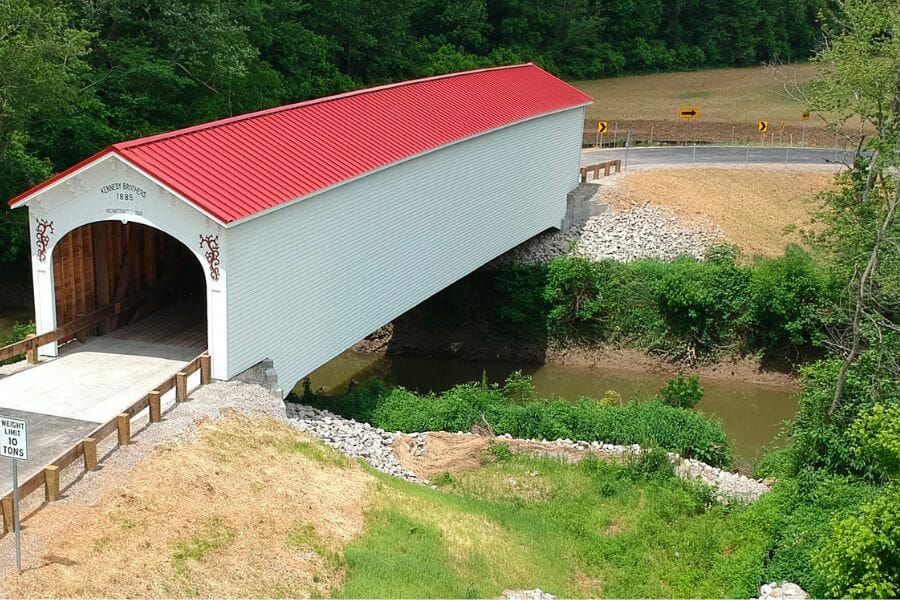
Beanblossom Creek, which runs for about 17 miles, winds its way through some beautiful countryside. Its surroundings is mostly wooded, with some open fields here and there. There’s a lot of wildlife in the area, including deer, foxes, and different kinds of birds. Around the creek, the terrain is pretty flat, but there are some gentle hills in the distance.
The geology around the creek is mostly sandstone and shale. There are some really interesting rock formations to check out, too. The creek itself is pretty clear and shallow in some spots, and deeper in others. Which is why it’s a great spot to go geode hunting!
But before you plan your trip here, make sure to check the updated collecting guidelines of Indiana.
Where we found geodes at Beanblossom Creek
Geodes can be found pretty much on any part of the Beanblossom Creek, so when you go geode hunting here, make sure you explore all the areas of this location.
If you want REAL results finding incredible rocks and minerals you need one of these 👇👇👇
Finding the coolest rocks in isn’t luck, it's knowing what to look for. Thousands of your fellow rock hunters are already carrying Rock Chasing field guides. Maybe it's time you joined the community.
Lightweight, mud-proof, and packed with clear photos, it’s become the go-to tool for anyone interested discovering what’s hidden under our red dirt and what they've already found.
Join them, and make your next rockhounding trip actually pay off.
What makes it different:
- 📍 Find and identify 140 incredible crystals, rocks, gemstones, minerals, and geodes across the USA
- 🚙 Field-tested across America's rivers, ranchlands, mountains, and roadcuts
- 📘 Heavy duty laminated pages resist dust, sweat, and water
- 🧠 Zero fluff — just clear visuals and straight-to-the-point info
- ⭐ Rated 4.8★ by real collectors who actually use it in the field
Brown County
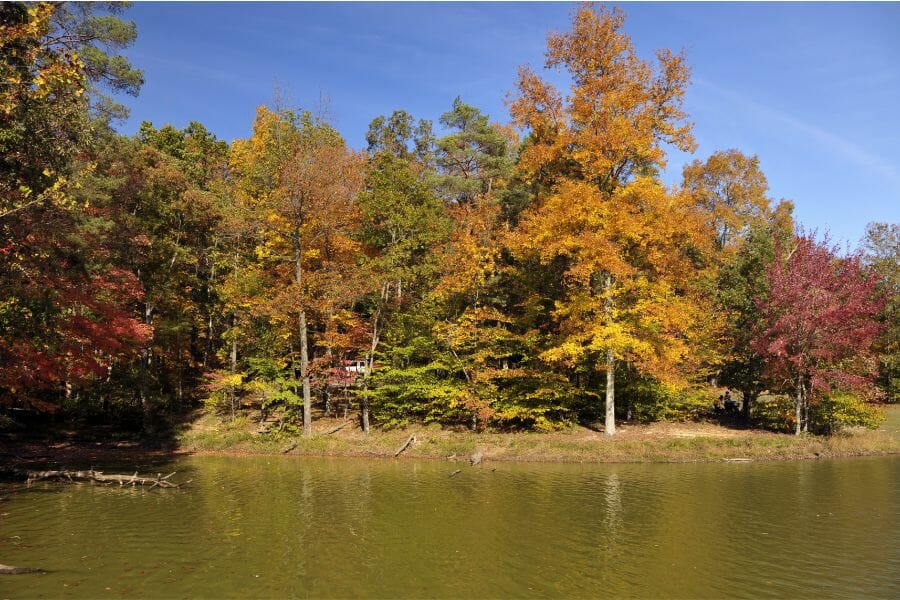
Brown County is a really great place to visit and check out if you’re into geode hunting. Its geography is super diverse, with lots of rolling hills, dense forests, and winding rivers. The terrain can be pretty rugged in some spots, but there are also some nice flat areas.
The geology of Brown County is mostly sandstone and limestone, with some shale mixed in. The are has amazing cool rock formations, including caves and cliffs.
Going here is easy, especially if you’re driving. There are a few major highways that run through the area, so you can get there from pretty much anywhere in the state. There’s also a small airport nearby if you’re flying in. No matter how you plan to go here, it’ll be worth it!
Where we found geodes in Brown County
This county has tons of areas where you can find geodes, including in the road and road cuts throughout the county, stream beds, banks, cliffs, washes, pits, and quarries. Specifically, you can search for geodes in the following spots:
- Brown County State Park
- Beanblossom Creek
- Yellowwood Trail
- Blummets Creek
Lawrence County
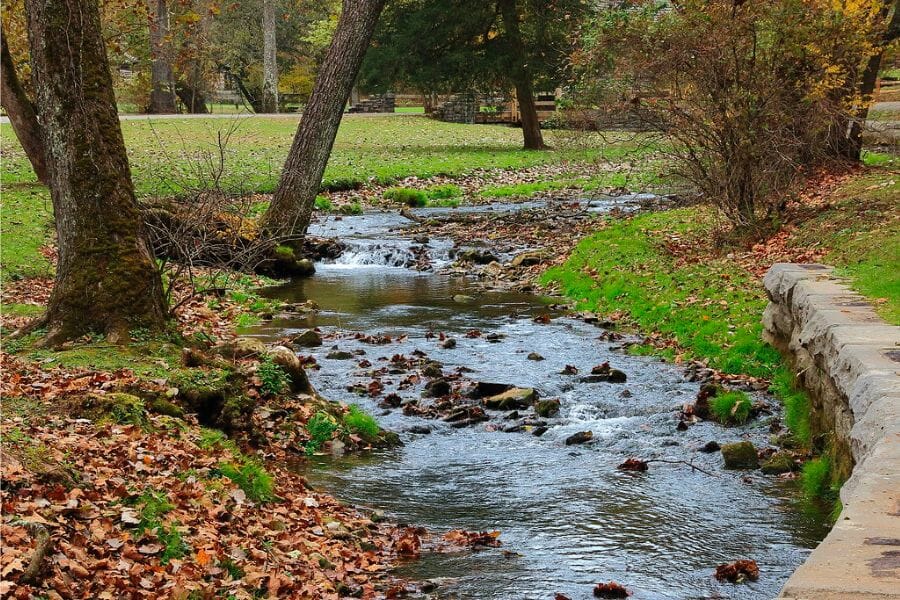
Lawrence County is situated in the southern part of our state. Its terrain is pretty diverse, with everything from flat fields to rolling hills. It’s home to several rivers and streams, including the White River, which runs through the heart of the area.
This county mostly has limestone, with some sandstone and shale mixed in. There are some really cool caves and rock formations here, too.
Getting here is a breeze, especially if you’re driving because several major highways run through here. If you’re from outside our state, you can also fly in as there’s a small airport nearby. So if you’re looking for a great spot to explore and to go geode hunting in Indiana, Lawrence County is definitely worth checking out!
Where we found geodes in Lawrence County
Lawrence County doesn’t run out of areas to explore if you want to find amazing geodes. You can find them in all regional stream beds and banks, road and road cuts, pits, and excavations around the towns of Clearsprings, Erie, Guthrie, Heltonville, Pinhook, Tunnelton, and Zelma. You can also visit and look into the following spots:
- Bedford Creek
- State highway road cuts
- Salt Creek
Salt Creek
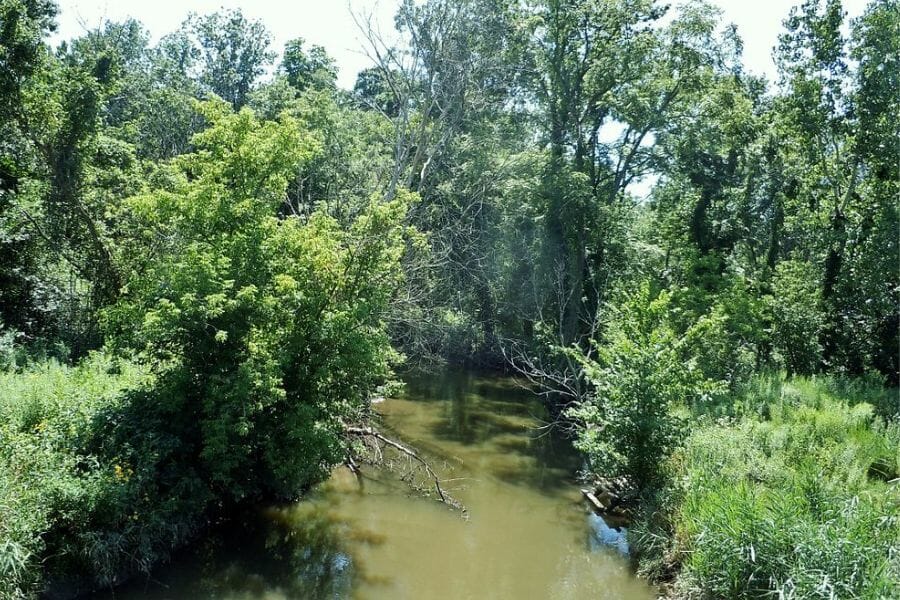
Truly a hidden gem, Salt Creek runs through several counties in the southern part of the state. The terrain around it is pretty diverse, with some areas being hilly and rocky, while others are flat and grassy.
The geology of the area is mostly limestone, with some sandstone and shale mixed in. Aside from geode hunting, if you’re also into hiking and exploring, there are some really cool rock formations and caves here.
Visiting here via car is easy as there are several access points along the creek, with some being more popular than others. And when you visit, make sure you have loads of energy to make the most of your trip!
Where we found geodes at Salt Creek
The gravels of Salt Creek extending to the Bedford area streams and their banks are the specific areas where you can find some of the most amazing geodes here, including Quartz geodes.
Jackson County

Jackson County is a real treat for nature lovers— and geode hunters! It’s located in the southern part of our state, and it’s got some seriously beautiful terrain. From rolling hills to winding rivers, this place has it all.
The geology of Jackson County is mostly limestone, with some sandstone and shale mixed in. This is why the place has some interesting formations and rock and mineral reserves that will truly amaze you.
You won’t have a hard time reaching this place if you’re driving. There are several major highways here, so you can get here from any part of Indiana. Just be sure to bring your hiking boots and your sense of adventure!
Where we found geodes in Jackson County
If you’re here, chances are you’re near a geode which is so cool! But if you want to be sure you’ll find one, we recommend exploring the following spots:
- White River
- Delaney Creek Road
Other Great Places To Dig For Indiana Geodes
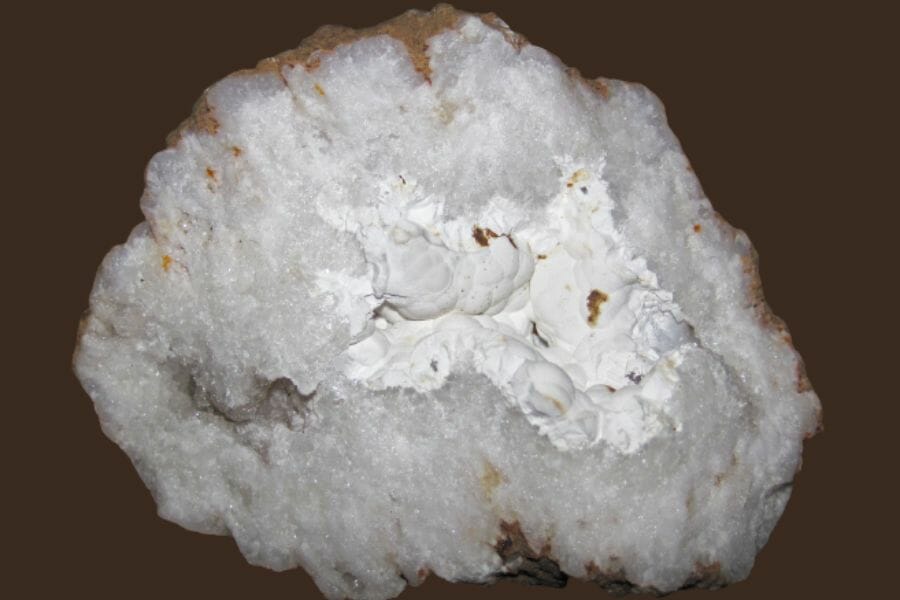
Indiana is amazingly blessed with bountiful geodes, so the places we shared above are not the only spots where you can find geodes here. In fact, there are plenty more! To make your search for geodes easier, we listed these places by county below. For those where we put, “county wide”, we will provide more specific details in the succeeding sections.
Our recommendations by county
| County | Location |
| Brown | County wide |
| Brown | Along Beanblossom Creek |
| Brown | 100’ north of Entrance to Brown County State Park |
| Brown | Stream beds, particularly Bear Creek in Trevlac area |
| Brown | Along the Yellowwood Trail, west of Yellowwood State Forest in Nashville area |
| Brown | SR-45 to Blummets Creek, upstream and down along creek |
| Huntington | Erie Stone Company Quarry |
| Jackson | County wide |
| Jackson | In East Fork of the White River in Medora area |
| Jackson | Creekbed of Delaney Creek Road |
| Lawrence | County wide |
| Lawrence | Bedford Creek banks |
| Lawrence | Roadcut along State Highway |
| Lawrence | Area excavations, stream gravels, pits, road cuts, and banks of Guthrie |
| Lawrence | Area stream gravels and outcrops of Erie |
| Lawrence | Heltonville area and other area streams |
| Lawrence | Salt Creek gravels |
| Lawrence | In fields surrounding the Tunnelton area |
| Miami | Area stream banks, raod and road cuts, excavations of Erie |
| Monroe | In road cut of Bloomington on Rte. 37 |
| Washington | Minnie Holstine Farm |
| Washington | East of SR-56 to edge of town at the Jim Day Farm |
| Washington | 0.9 miles north on SR-135 to creek of Salem area |
Additional areas you should try
Some of our recommendations above say “county wide”, which may be too broad and too wide especially if you’re new to geode hunting, so we’ll narrow it down for you. Here are some of the specific places that you can explore to find geodes in Indiana:
Streams and Creeks
Streams and creeks are constantly moving, which means that geodes are constantly being shifted around. This makes them great places to find all sorts of interesting specimens. Additionally, the flowing water can help to wear away the outer layers of rocks, exposing new colors and textures underneath.
Another benefit of searching for geodes in streams and creeks is that the water can help to wash away dirt and debris, making it easier to see what you’re looking for. So be sure to check these waters out. You never know what geodes you might uncover!
Quarries
Quarries are man-made mines that are dug into the ground to extract minerals and rocks. These rocks are often exposed and readily available for the taking, which can make them easier to find than in other locations.
Furthermore, quarries often expose geodes that aren’t typically found on the surface. The deeper you dig, the more likely you are to find something truly unique and special.
Rivers and Riverbanks
As natural waterways that flow across the landscape, rivers can pick up and transport rocks and minerals from upstream locations, eventually depositing them in their riverbeds. One great thing about searching for geodes here is that the constant flow of the river can help to uncover specimens that may have been buried beneath the surface.
Another benefit of searching for geodes in riverbeds is that they are often located in picturesque and serene settings. It’s a great way to enjoy nature while indulging in rock collecting and geode hunting!
Road Cuts
Rocks and minerals, including geodes, are usually covered by grass, trees, farmland, buildings, parking lots, that make it very difficult to find out what is under the surface. In those areas, road cuts are a great way to see the reserves that are normally hidden.
Road cuts are among the best places you can search geodes in because they can reveal different layers of rock and minerals that are normally difficult to see.
Common Geode-Hunting Questions
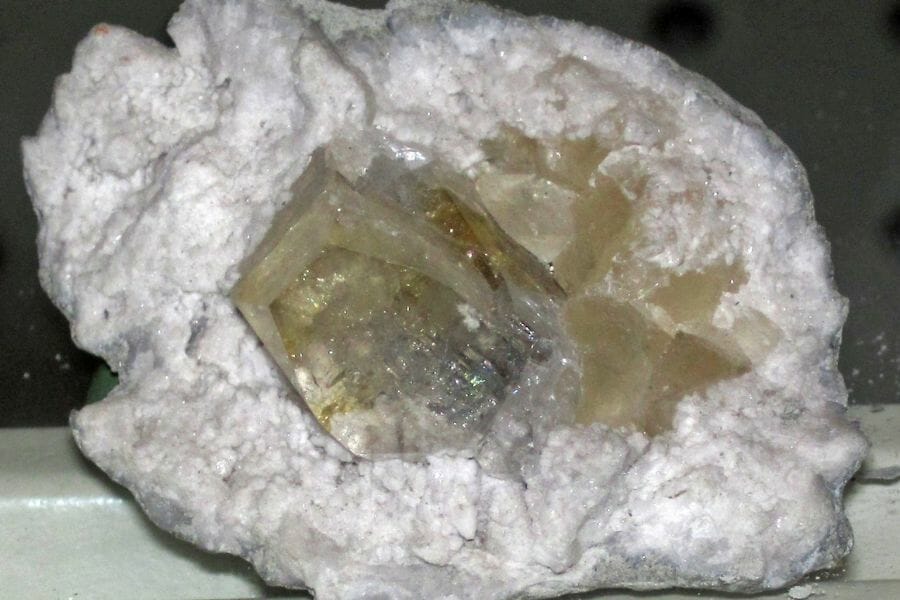
We gathered and answered some of the most common frequently asked questions of people who search for geodes in Indiana. Here are the top two of them:
Where can you find amethyst geodes in Indiana?
While Indiana is rich in geode reserves, unfortunately, it doesn’t have amethyst geodes. But if you’re after this particular type, don’t worry because they’re readily available for purchase in the local shops. We made a list of the best ones below.
Is it illegal to collect geodes in Indiana?
Generally, collecting geodes in Indiana is legal for as long as you follow our local collecting laws. If you’re collecting from government land, check out any local regulations in place. Also, don’t start exploring any private land until you get permission from the owner.
The Best Places To Buy Geodes In Indiana
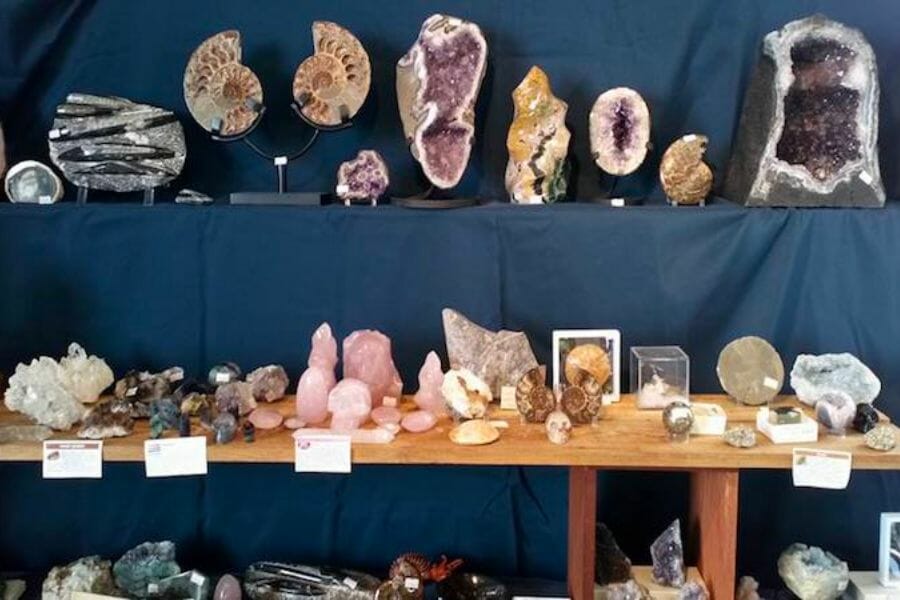
Trekking and searching for hours is not for everybody, and if you’re somebody who prefers to just get a beautiful geode to add to your collection, we compiled and listed down the best local shops in Indiana.
We made sure to include the links and addresses to these shops so you can easily visit them:
- Geodes and Gemstones – 300 Hwy 35 N, Knox, IN 46534
- Amazon – You’ll be surprised at the pretty good variety of geodes on Amazon. In fact, aside from geodes that are ready to be cracked open, they even have complete sets of kits to break them open!
- Love Rocks Lapidary – 16624 Winchester Rd, Ossian, IN 46777
- Earths Creations – 110 E Main St, Knightstown, IN 46148
- Earth Wear Rock Shop – 309 W Main St, Plainfield, IN 46168
- All My Relations – 7218 Rockville Rd, Indianapolis, IN 46214
- The Crystal Lady – 192 W Joliet St Suite B, Crown Point, IN 46307
- Merlin’s Treasure Trove – 825 S 5th St, Terre Haute, IN 47807
- Mystical Moon – 103 E Main St Suite B, Knightstown, IN 46148
- Metamora Gem MIne – 19055 Main St, Metamora, IN 47030
Additional places to find geodes in nearby states
Check out our guides for nearby states if you’ve already tried all of our suggestions above or if you’re planning a trip outside of the state:
If you have any recommendations for our list please leave a comment below!

